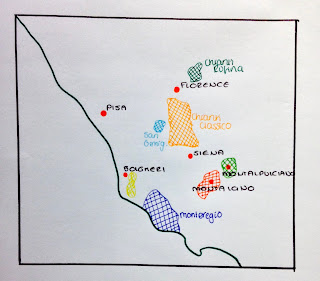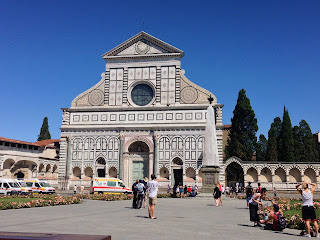Brunello di Montalcino
Brunello di Montalcino
A wine you've most likely heard of, you would probably be confident enough to order it and expect a fairly powerful taste - but what is it? A grape? A region? A style of wine? It's a wine full of history, character and passion, so read on if you fancy learning a bit more about one of the most important wines of Italy!
Brunello di Montalcino - Brunello "of" Montalcino, therefore Brunello is the grape, and Montalcino is the area. Pretty easy to remember. Brunello is in fact Sangiovese, Sangiovese Grosso to be exact - it's a bigger version than we see in the Chianti region, with thicker skins so higher tannins and colour (so more capable of ageing).
Montalcino is in Tuscany, a bit further south of the Chianti region, just below Siena:
The area of Montalcino is situated on top of a hilly area surrounded by 4 very important rivers, which are both vital factors of the production of these wines. The climate here is typically Mediterranean, with rain concentrated in the spring and autumn months, it's fairly mild hence the gradual ripening of the berries, which in turn produces wine capable of fantastic quality. In the bottom of the valley of the Orcia river, thick clay deposits dominate; producing wines with lots of colour, more tannins and lots of black fruit - a more modern winemaking approach is seen here. Wines produced from areas with a higher elevation with shallower soils of rocky shale and clay tend to be slightly lighter bodied, with more red fruits and floral notes. This elegant style of wine is more suited to the traditional winemaking approach.
The ageing of Brunello plays a very important factor in the production of the wine. It is required to aged for a minimum of 5 years prior to the release; 2 years minimum in oak, and 4 years in bottle. For the Riservas 6 years in oak is required, with a further 6 years minimum in bottle.
As mentioned above, you will generally see 2 different approaches for the production of Brunello; a traditional method or a more modern outlook. The traditional method uses large used Slavonian oak barrels, which doesn't give too much oak flavour to the wine, and are used primarily to encourage tertiary flavour development in the wine through oxygen exposure. For these wines you will see more flavours of dried fruits and leather, they also have a greater potential to age. For the modern winemakers of Brunello, the use of smaller new French oak barrels is more common, with give notes of vanilla, brown sugar and chocolate. These wines tend to be ready to drink sooner, due to the fact that oxygen exposure is increased (more oak to wine surface area).
So if that has urged to go out and buy a bottle, heres some top vintages to look out for;
1997; wines from this year see lots of tertiary flavours, a definite favourite of mine when I'm looking for a fully developed wine to enjoy on a special occasion.
2001; again lots of tertiary flavours, but more dried fruit flavours still showing.
2004; a wine to drink now, seek these out if your looking to drink something right away, it was a very perfumed vintage with great balance.
2006; a very fruit forward vintage yet remain to keep their complexity. Ready to drink and very enjoyable!
2007; an outstanding vintage giving lots of ripe fruit with a soft structure than the norm. It's a fairly well priced vintage so definitely worth seeking out.
2009; a warm summer produced elegant, fruity wines with plenty of body and ready to drink now.
2010; a fantastic year seen almost everywhere! I was lucky to buy a few cases a few years back and am currently patting myself on the back. They are drinking very well now, but will be showing their full potential 2018 onwards, so be patient!
2012; another fantastic vintage to look out for if your interested in ageing some wine.
2015; a very well balanced vintage, showing lots of fruit, tannins and acidity. A vintage to buy and age for another decade or so.
But wait, there's more!
Montalcino isn't just about the its' Brunellos'; Rosso di Montalcino offers a great alternative at a cheaper price point. It's the same grape and has similar strict regulations and many of the declassified Brunellos actually end up in this category - so there's definitely a few bargains to be had from this category. It's basically a younger wine from the same vineyards, which is traditionally to be enjoyed whilst waiting for the Brunellos to age and be ready to drink, or to make use of the younger vines intended to make Brunello once they've matured a little. This wine will see 1 year ageing before release, there's no oak requirements so results in a wine with a lighter body, lots of red fruit and perfumed notes and less tannins.
Just to get you up to speed, here's a few of my favourite Brunello producers at the moment;
Castello Romitorio, Le Ragnaie, Uccelliera, Sesti, Podere Brizio, Canalicchio di Sopra, Lisini, Col d'orcia, Col di Lamo, Brunelli, Caparzo, Casanova di Neri, San Polo, Costanti, Cerbaia, Poggio di Sotto, Sassetti, Pieve Santa Restituta, Il Poggiolo, Il Poggione, Tenuta Vittoria, Piombaia, Marchesato degli Aleramici, La Togata, Il Vino dei Poeti.
Many of these are available at Antiche Dogane in Florence, Italy - just a few steps from the Duomo on Piazza Sant'Elisabetta (it's also where I work, so come and enjoy bottle if your ever in Florence!)
A wine you've most likely heard of, you would probably be confident enough to order it and expect a fairly powerful taste - but what is it? A grape? A region? A style of wine? It's a wine full of history, character and passion, so read on if you fancy learning a bit more about one of the most important wines of Italy!
Brunello di Montalcino - Brunello "of" Montalcino, therefore Brunello is the grape, and Montalcino is the area. Pretty easy to remember. Brunello is in fact Sangiovese, Sangiovese Grosso to be exact - it's a bigger version than we see in the Chianti region, with thicker skins so higher tannins and colour (so more capable of ageing).
Montalcino is in Tuscany, a bit further south of the Chianti region, just below Siena:
The ageing of Brunello plays a very important factor in the production of the wine. It is required to aged for a minimum of 5 years prior to the release; 2 years minimum in oak, and 4 years in bottle. For the Riservas 6 years in oak is required, with a further 6 years minimum in bottle.
As mentioned above, you will generally see 2 different approaches for the production of Brunello; a traditional method or a more modern outlook. The traditional method uses large used Slavonian oak barrels, which doesn't give too much oak flavour to the wine, and are used primarily to encourage tertiary flavour development in the wine through oxygen exposure. For these wines you will see more flavours of dried fruits and leather, they also have a greater potential to age. For the modern winemakers of Brunello, the use of smaller new French oak barrels is more common, with give notes of vanilla, brown sugar and chocolate. These wines tend to be ready to drink sooner, due to the fact that oxygen exposure is increased (more oak to wine surface area).
So if that has urged to go out and buy a bottle, heres some top vintages to look out for;
1997; wines from this year see lots of tertiary flavours, a definite favourite of mine when I'm looking for a fully developed wine to enjoy on a special occasion.
2001; again lots of tertiary flavours, but more dried fruit flavours still showing.
2004; a wine to drink now, seek these out if your looking to drink something right away, it was a very perfumed vintage with great balance.
2006; a very fruit forward vintage yet remain to keep their complexity. Ready to drink and very enjoyable!
2007; an outstanding vintage giving lots of ripe fruit with a soft structure than the norm. It's a fairly well priced vintage so definitely worth seeking out.
2009; a warm summer produced elegant, fruity wines with plenty of body and ready to drink now.
2010; a fantastic year seen almost everywhere! I was lucky to buy a few cases a few years back and am currently patting myself on the back. They are drinking very well now, but will be showing their full potential 2018 onwards, so be patient!
2012; another fantastic vintage to look out for if your interested in ageing some wine.
2015; a very well balanced vintage, showing lots of fruit, tannins and acidity. A vintage to buy and age for another decade or so.
But wait, there's more!
Montalcino isn't just about the its' Brunellos'; Rosso di Montalcino offers a great alternative at a cheaper price point. It's the same grape and has similar strict regulations and many of the declassified Brunellos actually end up in this category - so there's definitely a few bargains to be had from this category. It's basically a younger wine from the same vineyards, which is traditionally to be enjoyed whilst waiting for the Brunellos to age and be ready to drink, or to make use of the younger vines intended to make Brunello once they've matured a little. This wine will see 1 year ageing before release, there's no oak requirements so results in a wine with a lighter body, lots of red fruit and perfumed notes and less tannins.
Just to get you up to speed, here's a few of my favourite Brunello producers at the moment;
Castello Romitorio, Le Ragnaie, Uccelliera, Sesti, Podere Brizio, Canalicchio di Sopra, Lisini, Col d'orcia, Col di Lamo, Brunelli, Caparzo, Casanova di Neri, San Polo, Costanti, Cerbaia, Poggio di Sotto, Sassetti, Pieve Santa Restituta, Il Poggiolo, Il Poggione, Tenuta Vittoria, Piombaia, Marchesato degli Aleramici, La Togata, Il Vino dei Poeti.
Many of these are available at Antiche Dogane in Florence, Italy - just a few steps from the Duomo on Piazza Sant'Elisabetta (it's also where I work, so come and enjoy bottle if your ever in Florence!)




Comments
Post a Comment